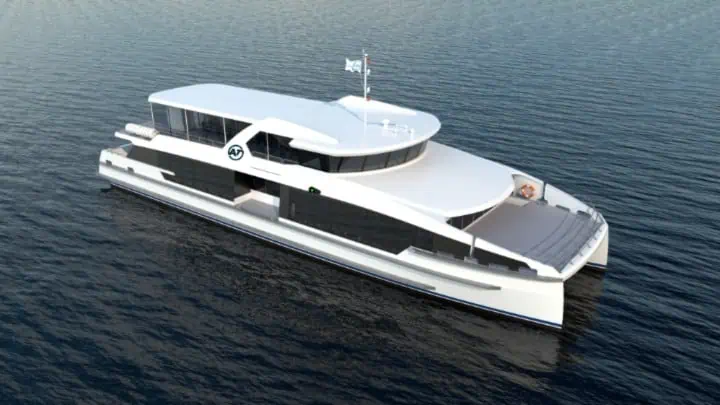Auckland Transport (AT) has signed contracts with Q-West Boat Builders and HamiltonJet to build a 300 passenger hybrid-electric ferry.
This is the fourth low emission ferry confirmed for Auckland and the second being built by Q-West. AT plans to use this vessel on the Devonport route from 2026.
It is part of a wider programme that will see Auckland become a world leader in this space. By 2030, Auckland is set to have the largest electric ferry fleet in the Southern Hemisphere.
Councillor and Chair of Auckland’s Transport & Infrastructure Committee John Watson, says that the programme will see Auckland’s vessels move from private ownership to public ownership. Owned by Auckland (via AT) for the benefit of Auckland.
“It is a significant commitment to reduce emissions, improve reliability, and protect the Waitematā for future generations,” says Councillor Watson.
Auckland’s first two fully electric vessels will arrive next year, built by EV Maritime at Auckland boat builders McMullen and Wing, followed by Q-West’s two electric-hybrid vessels in 2025-2026. More will follow in the coming years as the current fleet of diesel ferries reach the end of their working life.
These new vessels will operate hand in hand with owner operated vessels as part of the transition to low emission vessels over the coming years.
AT’s Programme Director for the Low Emission Ferry Programme, Nathan Cammock, says it is incredibly exciting to see Auckland and New Zealand continuing to lead the way with modern, low emission public transport.
“As part of AT’s Mission Electric, we are investing in low emission public transport right across our network. Our trains are electric, all new bus purchases will be electric and now ferries will be too.”
This most recently announced vessel will start construction in late 2023 and be on the water early 2026.
It will be identical to the vessel Q-West are currently building, at 32 metres long with space for 300 passengers and around 28 bikes.
“Our new low emission ferries have greater passenger capacity, improved accessibility, and a more consistent customer experience compared to our current fleet.”
With significantly more space for bikes it will make it easier for people to cycle at either end of their ferry trip”, says Mr Cammock.
Q-West Boat Builders, Hamilton Jet and Incat Crowther are again part of the team building the new vessel. Fullers360 are project managing the build on behalf of AT.
Q-West Chief Executive Colin Mitchell is delighted Q-West has been selected to construct the second 32 metre hybrid ferry,
“This new vessel will likely be completed in Q-West’s new facility at the Whanganui Port where we will be able to maintain and repair ferries and other commercial craft.
“We look forward to continuing our relationship with Auckland Transport and Fullers360,” says Mr Mitchell.
Fullers360 CEO Mike Horne says Fullers360 has made substantial investment in green tech research and development over the last five years, which will power these ferries.
“As a key partner in the project as well as initiating and project managing the build, we can’t wait to see these low emission vessels out on the Waitemata”, says Mr Horne.
HamiltonJet’s Managing Director, Ben Reed, says the business is thrilled to be providing the hybrid power and propulsion solution for these hybrid vessels.
“This marks a transition in our business towards sustainable technologies and we are highly appreciative of Auckland’s global leadership in green commuter ferries”, says Mr. Reed.
The vessel is planned to cost around $20m, with 49% coming from Auckland Council’s Climate Action Targeted Rate and 51% coming from Waka Kotahi.












